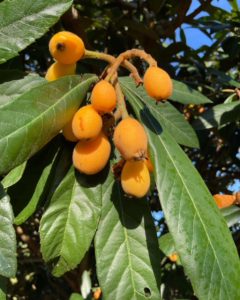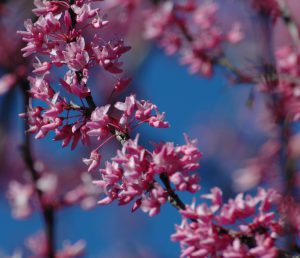The following series of columns entitled ‘Soil to Sky’ are an examination of five different facets of environment, structure, and life that are instrumental to trees in our forests and landscapes. Trees are instrumental to our wellbeing, both individually and collectively as a society. Healthy urban forests and natural areas are the responsibility of professional arborists, policy-makers, volunteers and individuals, among others. We will be sharing our enthusiasm with you in weekly installments and encourage you to become tree stewards, heralding forth the future of healthy trees. See the previous columns here: Soil, Roots, Stem, Leaves and Branches.
Flowers and Fruits by Alyssa Vinson

What function does beauty serve? The curving lip of petal, shimmering lightly, dappled with dew, or straying pollen, an enticement, a banner, an advertisement to passersby. Trembling with seasonality, the ephemeral flower to bud, to fruit, or seed is the cyclical reminder of life’s rush to attenuate. Whether primordial etched in the initial evolutionary successes of form and function, like cones, on gymnosperms or complex, like flowers and fruits on angiosperms they all have one goal: reproduction.
From coated seed swelling forth new trunks, branches, roots, and leaves, whether dicotyledon or monocotyledon, the first leaves emerge seeking the sustenance of sunlight. How do the seeds find their way to the right place at the right time, the environment rich for their bursting shoots? An intricate symphony of plant, animals, insects, and relationships in the environment lead to this newly formed life.
From stamen to stigma, borne singly, self-pollination or between individuals of the same species, pollen is transported by wind, water, insect, mammal, or bird. Rooted in place, trees, like other terrestrial plants, rely on relationships to facilitate reproduction. While it is possible for some individuals to reproduce alone, it is more often preferred to have a broad sampling of available partners to provide genetic information and diversity as key to resilience and health in plant populations. To entice this partnership of genetic transportation, plants evolved unique incentives: flowers and fruit.
Surrounded by brilliant corolla, bathed in scent, the flower, as we know it, evokes cherished recollections of raindrops on petals, or the slow droning of robust bumblebees in the lazy summer afternoons. Watching the petals fall as the base of the flower swells with the promise of delicious fruit. Fingers holding ripened flesh to lips, teeth bursting skin and dividing sweet flesh, juices overwhelm, that first taste of summer fruit. Or minutely hidden, unseen flowers, enticing insect visitors with the whiff of nectar, grown immense with their capped hats, acorns to fall.

Trees provide abundance through the magical transformation of sunlight to sugar, these sugars released, in reciprocity, for movement. A bee hovers gracefully, alights and sips, while trundling away with pockets of pollen to visit a neighboring flower, that neighbor fertilized, produces delectable fruit which is eaten by a bird which carries the genetic information kilometers from the parent tree. As health and diversity is ensured for the tree, so too is a food source sustained for the multitudes.
We surround ourselves with the beautiful and functional, planting trees not only for the broad swathe of ecosystem services provided, but more often for their simple beauty. Shade, form, structure, texture, flower, and fruit, all carefully considered when we plant trees in our landscapes and urban areas. Our relationship with flowering and fruiting trees is more than gastronomic, they figure prominently in our religions, literature, and art. Symbolizing, wisdom, regeneration, knowledge, and bounty, fruiting trees follow human travel across the landscape and often create or define a foundation of human settlement.
This series is written collaboratively by Alyssa Vinson and David Outerbridge.
 2
2
